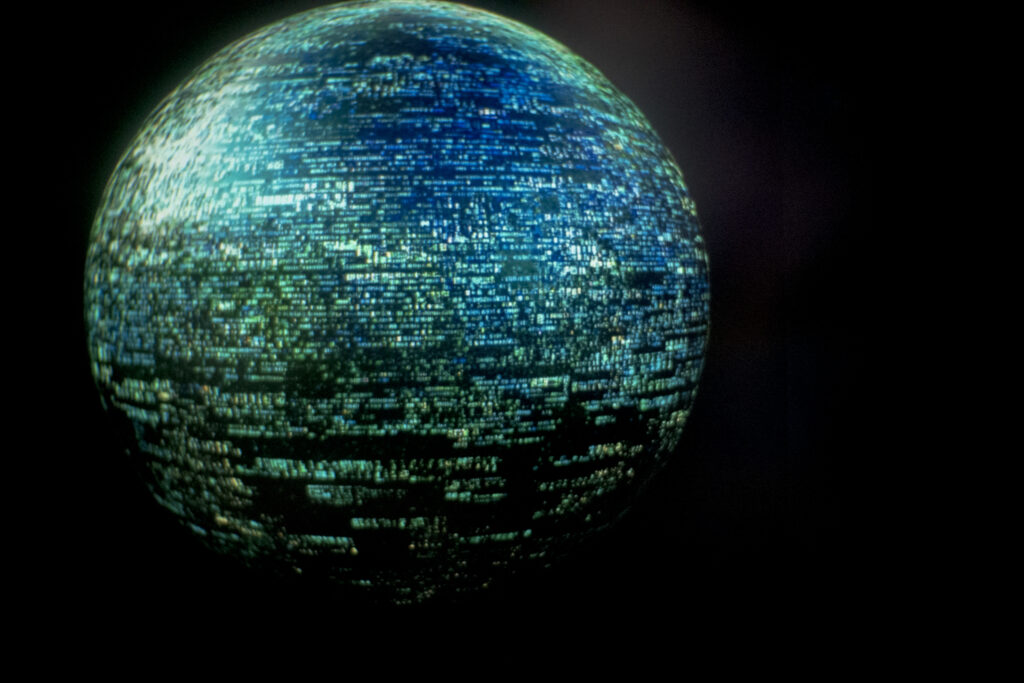
A photograph of an image created with Midjourney, a popular generative AI application for making pictures from textual or visual prompts. (Alexander Castro/Rhode Island Current)
Global temperatures are at an unprecedented high. Sea levels are rising. Climate-driven natural disasters are destroying communities with alarming regularity.
Our planet’s in a tough spot.
Enter a silver bullet: technology that could change everything, ending our downward spiral once and for all. I am talking about artificial intelligence
Except AI might just destroy the planet before it can save it. While some applaud AI’s ability to address the climate crisis, others express concern about its energy and water usage. However, the real threat to the climate lies in the ways AI can be applied, as a tool for those that contribute most to the dire state of our planet.
There’s no question AI can make an impact in addressing the climate crisis. It can maximize renewable energy sources, help farmers find more sustainable agricultural practices, and can even reduce waste in manufacturing. Unfortunately, that’s not the only impact this revolutionary technology is having on the environment. The rise of AI has necessitated the construction of data centers, which consume distressing amounts of energy and water. The average data center consumes the same amount of energy it takes to heat 50,000 homes each year, and data centers are increasing their water usage by over a billion gallons per year. Many worry that large language models are damaging the environment more than they’re helping it, and for good reason.
However, it’s possible that we aren’t quite worried enough. As data centers are hurting the planet through their own energy and water usage, their technology is enabling others to do far worse. Training the popular large language model ChatGPT 3 produced an estimated 500 tons of CO2. The fossil fuel industry alone produced 31.75 billion tons of CO2 in 2022. Comparatively, AI seems pretty far down our list of climate woes. Yet those two things are connected. Oil and gas giant ExxonMobil publicly uses Microsoft’s Azure, an AI technology that they claim will increase their production by 50,000 oil equivalent barrels per day. The thousands of additional tons of CO2 from just those barrels make ChatGPT’s emissions seem pretty tame.
Many worry that large language models are damaging the environment more than they’re helping it, and for good reason. However, it’s possible that we aren’t quite worried enough.
Artificial intelligence could exacerbate environmental harm in areas beyond just the fossil fuel industry. As AI gets better at optimizing production for virtually every industry, those industries also get more harmful. Take for example fast fashion. The fast fashion industry refers to the plethora of companies that make cheap clothes by cutting corners in terms of sustainability and working conditions. This industry is one of the biggest contributors to climate change, accounting for 10% of all carbon emissions. It is also the second largest consumer of water and contributes an obscene amount of waste in the form of clothing. I personally am very aware of how I contribute to that waste. I buy fewer clothes and only get rid of them when it’s really necessary, but AI doesn’t have that awareness. It works solely for the clothing companies, allowing fast fashion to be even faster. It can track current trends and help companies cut down their already impressive production time. In addition, it can be used for targeted advertising, increasing consumption. All of this leads to increased production and thus more waste, energy and water usage, and carbon emissions.
This summer, Rhode Island created an artificial intelligence task force, and legislators introduced multiple bills on regulating artificial intelligence during the General Assembly’s 2024 legislative session. As we begin to regulate AI, it is important to remember just how far it reaches. In order to curb its effect on climate change, we cannot just regulate data centers. We must also restrict how AI is used. The problem is how, since we know so little about the impacts of artificial intelligence. What are its limits? Is it possible to ensure it makes ethical decisions? What exactly does a society look like in the age of AI? Clearly, more research is needed, but that research must be followed by regulations. Our climate issue is already out of hand and it is vital that we take action now to limit AI’s potential to further harm the planet.
It is not yet clear exactly how AI will take shape in the next few years, but we already understand that it possesses nearly unfathomable potential. Profit-driven companies may capitalize on AI’s immense power to prioritize their own financial gain, ignoring their large environmental impacts. It is up to governments to step in and enforce regulations that ensure AI serves the interest of the planet, and it’s up to the people to hold leaders accountable. AI has the power to do incredible good. But we have to take steps to ensure AI is used appropriately to avoid a climate catastrophe.
GET THE MORNING HEADLINES.

